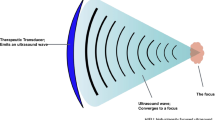Abstract
Objective: To study preliminary experience of high intensity focused ultrasound (HIFU) for unresectable malignant tumors in 75 patients. Methods: The clinical data of 75 patients with unresectable tumor was analyzed retrospectively. Results: Among 75 patients, ten out of 57 cases achieved good local control in short-term, 5 patients liver tumor, 4 patients with tumor in the chest wall and one patient with bone matestics. Seven patients had skin burn and 2 patients developed intestinal perforations. Conclusion: HIFU is a novel tool for local tumor treatment. HIFU treatment for patients with unresectable tumor in the chest wall is effective.
Similar content being viewed by others
References
Haaga J. Imaging-guided microsurgery and the future of radiology[J]. AJR 2000; 17: 303–4.
Haar T. High intensity focused ultrasound for the treatment of tumors[J]. Echocardiography 2001; 18: 317–22.
Ter-haar GR. Ultrasound focal beam surgery[J]. Ultrasound Med Biol 1995; 21: 1089–100.
Bihrle R, Foster RS, Sanghvi NT, et al. High intensity focused ultrasound for treatment of benign prostatic hyperplasia: early united states clinical experience[J]. J Urol 1994; 151: 1271–5.
Wu F, Chen WZ, Bai J, et al. Pathological changes in human malignant carcinoma treated with high-intensity focused ultrasound[J]. Ultrasound Med Biol 2001; 27: 1099–106.
Yang R, Reilly Cr, Rescorla FJ, et al. High-intensity focused ultrasound in the treatment of experimental liver cancer[J]. Arch Surg 1991; 126: 1002–9.
Goldberg SN, Gazelle GS, Mueller PR. Thermal ablation therapy for focal malignancy: a unified approach to underlying principle, and diagnostic imaging guidance[J]. Am J Roentagenol 2000; 174: 322.
Thuroff S, Chaussy C. High-intensity focused ultrasound: complications and adverse events[J]. Mol Urol 2000; 4: 183–7.
Sheen AJ, Poston GJ, Sherlock DJ. Cryotherapeutic ablation of liver tumors[J]. Br J Surg 2002; 89: 1396–401.
Goldberg SN, Gazelle GS, Halpern EF, et al. Radiofrequency tissue ablation: importance of local temperature along shape and size[J]. Acad Radiol 1996; 3: 212–8.
Miller MW, Miller DL, Brayman AA, et al. A review of in vitro bioeffect of intertial ultrasonic cavitation form a mechanic perspective[J]. Ultrasound Med Biol 1996; 22: 1131–54.
Malcolm AL, Ter Hear GR. Ablation of tissue volumes using high intensity focused ultrasound[J]. Ultrasound Med Biol 1996; 22: 659–69.
Hynynen K, Chung A, Colucci V, et al. Potential adverse effects of high-intensity focused ultrasound exposure on blood vessels in vivo[J]. Ultrasound Med Bio 1996; 22: 193–201.
Author information
Authors and Affiliations
Corresponding author
Additional information
Biography: ZHENG Guo-qiang(1959–), male, doctor of medicine, Peking University School of Oncology, Beijing Cancer Hospital, majors in surgical oncology.
Rights and permissions
About this article
Cite this article
Zheng, Gq. High intensity focused ultrasound for treatment unresectable malignant tumors in 75 patients. Chin. J. Cancer Res. 16, 302–304 (2004). https://doi.org/10.1007/s11670-004-0048-0
Received:
Accepted:
Issue Date:
DOI: https://doi.org/10.1007/s11670-004-0048-0




